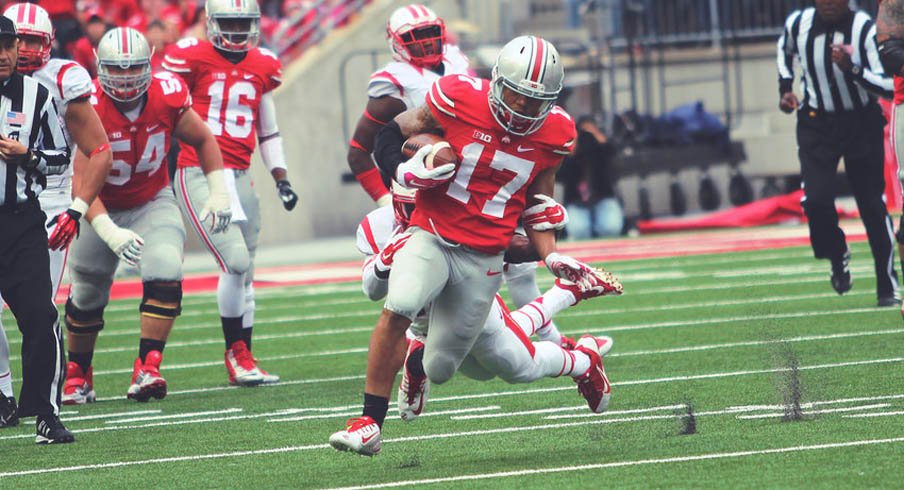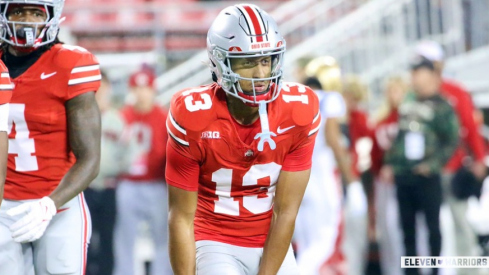Ohio State utilized its mid-range play action game and improving pass defense to jump out to an early lead and soundly defeat Rutgers.
The Buckeyes exploited a Scarlet Knights defense focused on the inside run game not only with the aforementioned play-action, but also by re-equating numbers with JT Barrett as a runner. And while the OSU defense was at time susceptible to misdirection, it successfully limited Rutgers' passing game, allowing the Buckeyes to quickly build a lead and coast to victory.
Accounting for the Quarterback
The Scarlet Knights generally aligned in their standard 4-3 under front, while frequently utilizing cover 2, man under in the secondary. While they utilized their base defense, Rutgers did focus upon Ohio State's tight zone play. Their inside linebackers would quickly flow downhill. And they would frequently bring outside linebackers on backside edge blitzes to attack the mesh point.
The Buckeyes responded with play-action and Barrett as a runner. Perhaps no play was more telling then Ohio State's fourth down conversion on its first drive. Just like other defenses this season, the Scarlet Knights were focused on the inside run in this short yardage situation. Tom Herman responded by dialing up quarterback lead wide zone, adding an additional blocker to equate numbers and getting the football outside the defense's support.
On the day, Barrett gained over 100 yards, include five runs over ten yards. Barrett's carries came in one of two ways -- either keeping on read plays in reaction to Rutgers' backside contain overplaying tight zone, or from scrambles on pass plays.
The latter is particularly important. Barrett repeatedly took advantage of Rutgers blitzing with underneath man coverage. This left the Scarlet Knights with no underneath defenders with eyes on the quarterback, opening running lanes.
In so doing, Barrett showed more burst. If Barrett continues to be successful scrambling it will limit the options available to opposing defenses.
Setting it Up
But the Buckeye offense primarily relied upon the mid-range passing game -- particularly off play action. Ohio State held the Scarlet Knight's intermediate man defenders with play fakes and then hit passes in front of Rutgers' two deep safeties.
One focus was pass concepts utilizing triangle stetches, creating a 2 on 1 versus the deep half safety. The Buckeyes first touchdown throw came on snag, followed by an explosive play off a flood pattern created by a similar triangle.
Ohio State also again featured the tailback on swing passes in the flat. This has been critical to the Buckeyes' offense since Virginia Tech. Given how aggressive defenses are playing the run, opposing linebackers cannot account both for the play fake and cover Ezekiel Elliot. Likewise the tight ends -- particularly Nick Vannett -- continue to be effective off play action in the intermediate areas vacated by run-focused linebackers.
To the Future
But the Buckeye did not necessarily utilize play-action because Rutgers was slowing down the Ohio State run offense. The Buckeyes could have run with far more frequently because Rutgers had little chance stopping the Ohio State run game with deep safeties.
But Herman's play calling served a purpose -- setting up future opponents. The more Ohio State demonstrates an effective play action passing game the tougher it will be for opponents to aggressively attack the inside run.
This was particularly important in short yardage and red zone opportunities, where the Buckeyes have occasionally struggled against man cover 0 looks. On Saturday, Ohio State utilized everything from play-action to five wide in such situations -- not only as a response to the coverage, but also to make opponents reconsider such defenses.
For the same reason, the Buckeyes largely stayed away from utilizing jet sweeps, while running direct snap wide zone with Dontre Wilson. The second half also provided the Buckeyes an opportunity to work on their short passing game.
In other words, Ohio State used their early lead as an opportunity to gain repetitions and break tendencies. Meyer and Herman minimized the amount they used their base inside and outside plays -- both to improve as an offense and to limit the ability of future defensive coordinators to overplay those looks.
Know Your Role
The offensive line and JT Barrett both deserve credit for the passing game's continued evolution. Rutgers has successfully pressured the quarterback this season. But the Ohio State offensive line kept the Scarlet Knights' pass rush at bay, largely handling Rutgers' stunts and blitzes.
For his part, Barrett continues to see the field well, make good decisions and handle pressure. While he may not have the strongest arm he delivers an accurate, catchable ball and leads receivers well with slants, crossing, and bender routes.
Barrett and the offensive line's improvement was on display on this third down and long completion off a drive shallow cross pattern. The Buckeyes' interior line of Jacoby Boren, Pat Elflein, and Billy Price picked up Rutgers' A-gap blitz and stunt, with Elflein nicely coming off to pick up the twist. The protection allowed Barrett to buy depth and deliver a perfect ball where Jalin Marshall could gain yards after the catch.
The Buckeye skill players are continue to find their roles. With four catches Michael Thomas solidified his spot as the primary receiver -- particularly in the short to medium passing game on routes such as double slants. Of the H slot receivers, Wilson is the Buckeyes' primary horizontal threat while Marshall is perhaps the more effective downfield receiver.
Elliot is clearly the most critical contributer, not only as a runner but also as a blocker and receiver. But Curtis Samuel's return demonstrates he must remain in the mix, as he is one of the Buckeye's biggest explosive play threats.
Stepping Forward
Although the Rutgers offense had a modicum of success against the Ohio State defense, the Buckeye defense largely limited what had been a proficient passing game. The Buckeyes did so by limiting explosive pass plays. While the Scarlet Knights had a few successful downfield throws, the Buckeyes limited any systemic issues in the back seven.
The Buckeye pass rush was also critical in preventing Rutgers from calling deep drops and attempting to push the football. Rutgers consistently chipped or double-teamed Joey Bosa, freeing other rushers. In response, defensive coordinator Chris Ash used stunts to free Bosa. For instance, Bosa's first sack came off an inside twist where nose guard Michael Bennett occupied the offensive tackle.
The Scarlet Knights' success primarily came off misdirection -- both from bootleg passing and cutbacks in the zone run game. This largely resulted from Buckeye linebacker over-aggressiveness. For instance, Rutgers had success in the flat by drawing in the walk-out linebacker with play action, leaving him out of position for his pass responsibilities in the Buckeyes' cover 4 scheme. Will linebacker Josh Perry was also suckered inside on the Scarlet Knights' first touchdown drive.
Linebacker over-pursuit was also the primary factor in Rutgers' limited rushing success -- particularly in the second half when Ohio State subbed liberally.
But the Scarlet Knights could not sustain drives because Ohio State largely controlled the line of scrimmage. This includes Steve Miller, who has played very soundly in recent weeks in place of Noah Spence -- particularly against the run.
The Buckeyes were also largely successful getting off the field on third down. The Buckeyes have become fairly effective operating Ash's nickel scheme. From a three-man pre-snap front, the Buckeyes switched between zone blitzing with a five-man three deep, two under coverage, to a four man rush backed with cover 2 or 3. Nickel Armani Reeves' versatility is critical to the scheme, with the ability to play the underneath hook-to-curl or drop to a deep middle.
The upshot is that the Buckeyes defense has been far better getting off the field then they were against Virginia Tech.
Getting Better
There is no better sign of the Buckeyes' improved defensive coaching under Ash then the unit's weekly improvement. One does not see the same mistakes popping up weekly -- opposed to last season. Most significantly, Ohio State has limited the explosive passing plays that plagued the unit earlier this season.
That is not to say the Buckeye defense is a finished product. Linebacker play remains uneven and the defense has significant drop-offs between the first and second string at certain positions. Nowhere is this more noticeable then when Ohio State spells tackles Bennett and Adolphus Washington.
Yet improvement continues in fits and starts. New contributors such as Eli Apple and Raekwon McMillan have made significant strides, to the point where it is difficult to take either off the field. Ohio State has been able to jump out to such commanding leads in recent weeks because the defense is getting off the field, allowing the offense to get the ball back in good field position and score quickly.
It is easy to dismiss Rutgers in light of the blowout win. Yet the Scarlet Knights entered the game 24th in Football Outsiders. Even if Rutgers never again meets those heights, the Buckeyes notched another easy win against a top-50 opponent.
Saturday's contest at Penn State will present a role reversal. The Buckeyes have recently faced teams with poor defenses and solid passing games. The Nittany Lions, by contrast, have struggled offensively, particularly along the offensive line.
But they have a stout defense, especially against the run. Operating from a 4-3 under, cover 3 shell, Penn State's front seven is experienced, led by MLB Mike Hull. So the Nittany Lions will provide a good test of how much the Buckeye offense -- particularly the offensive line -- has improved since Virginia Tech.


